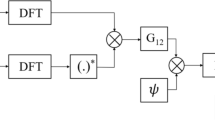Abstract
Direction of arrival (DOA) estimation has a wide range of applications in military and civilian fields. However, most methods are based on Gaussian noise assumptions. If the received signals contain impulsive noise, the performance of DOA estimation will be significantly reduced. Based on analyzing the properties of the Logistic function, a new kernel function is proposed, and its properties are analyzed and proven. Furthermore, a cost function is proposed. By applying this cost function to low-rank decomposition technology, a novel DOA estimation method for coherently distributed sources is proposed. The experiment results show that compared with the existing methods, this method can obtain high precision and highly robust DOA estimation for coherently distributed sources under strongly impulsive noise and a low generalized signal-to-noise ratio.


Similar content being viewed by others
Data availability
Not applicable.
References
Wang, X., Huang, M., Wan, L.: Joint 2D-DOD and 2D-DOA estimation for coprime EMVS-MIMO radar. Circuits Syst. Signal Process. 40, 2950–2966 (2021)
Farahat, A., Hussein, K.: Dual-band (28/38 GHz) MIMO antenna system for 5G mobile communications with efficient DoA estimation algorithm in noisy channels. Appl. Comput. Electromagn. Soc. J. 36(3), 282–294 (2021)
Zheng, Z., Mu, S.: Two-dimensional DOA estimation using two parallel nested arrays. IEEE Commun. Lett. 24(3), 568–571 (2019)
Schmidt, R.: Multiple emitter location and signal parameter estimation. IEEE Trans. Antennas Propag. 34(3), 276–280 (1986)
Roy, R., Kailath, T.: ESPRIT-estimation of signal parameters via rotational invariance techniques. IEEE Trans. Acoust. Speech Signal Process. 37(7), 984–995 (1989)
Barabell, A.J.: Improving the resolution performance of eigenstructure-based direction-finding algorithms. In: IEEE International Conference on Acoustics, Speech, and Signal Processing, Boston, vol. 8, pp. 336–339 (1983)
Sharman, K., Durrani, T.: ESPRIT-estimation of signal parameters via rotational invariance techniques. In: 25th IEEE Conference on Decision and Control. Athens, Greece (1986)
Liu, K.R., O’Leary, D.P., Stewart, G.W., et al.: URV ESPRIT for tracking time-varying signals. IEEE Trans. Signal Process. 42(12), 3441–3448 (1992)
Nikias, C.L., Shao, M.: Signal Processing with Alpha-Stable Distributions and Applications. Wiley, New York (1995)
Liu, T., Mendel, J.M.: A subspace-based direction finding algorithm using fractional lower order statistics. IEEE Trans. Signal Process. 49(8), 1605–1613 (2001)
Belkacmi, H., Marcos, S.: Robust subspace-based algorithms for joint angle/Doppler estimation in non-Gaussian clutter. Signal Process. 87(7), 1547–1558 (2007)
Qiu, T.: Development in signal processing based on correntropy and cyclic correntropy. J. Electron. Inf. Technol. 42(1), 105–118 (2020)
Cai, R., Yang, L., Qian, Y.: Development in signal processing based on correntropy and cyclic correntropy. J. Electron. Inf. Technol. 42(11), 2600–2606 (2020)
Qiu, T., Liu, H., Zhang, J., et al.: An improved time delay estimation method based on generalized cyclic correntropy. J. Electron. Inf. Technol. 43(2), 255–262 (2021)
Zhang, J., Qiu, T., Song, A., et al.: A novel correntropy based DOA estimation algorithm in impulsive noise environments. Signal Process. 104, 346–357 (2014)
Tian, Q., Qiu, T., Li, J., et al.: Robust adaptive DOA estimation method in an impulsive noise environment considering coherently distributed sources. Signal Process. 165, 343–356 (2019)
Jantti, T.P.: The influence of extended sources on the theoretical performance of the MUSIC and ESPRIT methods: narrow-band sources. In: IEEE International Conference on Acoustics, Speech, and Signal Processing (1992)
Tholl, D., Fattouche, M.: Angle of arrival analysis of the indoor radio propagation channel. In: IEEE International Conference on Universal Personal Communications (1993)
Valaee, S., Alaee, S., Champagne, B., Kabal, P.: Parametric localization of distributed sources. IEEE Trans. Signal Process. 43(9), 2144–2153 (1995)
Meng, Y., Stoica, P., Wong, K.: Estimation of the directions of arrival of spatially dispersed signals in array processing. IEE Proc. Radar Sonar Navig. 143(1), 1–9 (1996)
Shahbazpanahi, S., Valaee, S., Bastani, M.H.: Distributed source localization using ESPRIT algorithm. IEEE Trans. Signal Process. 49(10), 2169–2178 (2001)
Maslov, V.P.: Logistic approach to the dependence of efficiency of scientific-and-technical projects on resources. J. Bus. Manag. Sci. 1(2), 14–17 (2013)
Markovsky, I.: Low Rank Approximation: Algorithms, Implementation, Applications. Springer, London (2011)
Tsakalides, P., Ninias, C.L.: The robust covariation-based MUSIC (ROC-MUSIC) algorithm for bearing estimation in impulsive noise environments. IEEE Trans. Signal Process. 44(7), 1623–1633 (1996)
Funding
The authors did not receive support from any organization for the submitted work.
Ethics declarations
Conflict of interest
The authors declare no competing interests.
Ethical approval
Not applicable.
Additional information
Publisher's Note
Springer Nature remains neutral with regard to jurisdictional claims in published maps and institutional affiliations.
Rights and permissions
Springer Nature or its licensor (e.g. a society or other partner) holds exclusive rights to this article under a publishing agreement with the author(s) or other rightsholder(s); author self-archiving of the accepted manuscript version of this article is solely governed by the terms of such publishing agreement and applicable law.
About this article
Cite this article
Tian, Q., Cai, R. A novel DOA estimation method for distributed sources in impulsive noise environments. SIViP 17, 2991–2998 (2023). https://doi.org/10.1007/s11760-023-02519-w
Received:
Revised:
Accepted:
Published:
Issue Date:
DOI: https://doi.org/10.1007/s11760-023-02519-w




